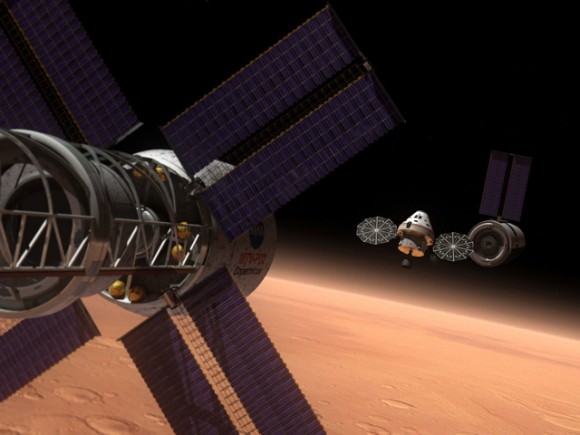The Multi-Purpose Crew Vehicle being assembled and tested at Lockheed Martin's Vertical Testing Facility in Colorado. Photo credit: Lockheed Martin
NASA has made a decision on their next crew vehicle, and now have plans to develop a “new” spacecraft called the Multi-Purpose Crew Vehicle (MPCV). NASA Administrator Charles Bolden announced today that the system will be based on designs originally planned for the Orion Crew Exploration Vehicle which was being built to return humans to the Moon. This decision shouldn’t come as a surprise, and it is not a huge leap or a big change for NASA — the Orion crew vehicle has been in continued development by Lockheed Martin and the company was already making changes in the vehicle for a proposed asteroid mission.
“We are committed to human exploration beyond low-Earth orbit and look forward to developing the next generation of systems to take us there,” Bolden said. “The NASA Authorization Act lays out a clear path forward for us by handing off transportation to the International Space Station to our private sector partners, so we can focus on deep space exploration. As we aggressively continue our work on a heavy lift launch vehicle, we are moving forward with an existing contract to keep development of our new crew vehicle on track.”
Artist's rendering of the Multi-Purpose Crew Vehicle on a deep space mission. Image credit: NASA
NASA said that Lockheed Martin will continue work on development of the MPCV, since they already have a test article built of the Orion. The spacecraft will carry four astronauts for 21-day missions and be able to land in the Pacific Ocean off the California coast. The spacecraft will have a pressurized volume of 690 cubic feet, with 316 cubic feet of habitable space.
It will serve as the primary crew vehicle for missions beyond low Earth orbit and be capable of conducting regular in-space operations (rendezvous, docking, extravehicular activity) in conjunction with payloads delivered by a launch system for missions beyond LEO. The MPCV could also be a backup system for ISS cargo and crew delivery.
A 21-day mission might get astronauts to a nearby asteroid, but there would not be enough time for a longer-duration, far-away asteroid mission and certainly not to Mars. It would get you to the Moon, allowing astronauts to stay a couple weeks and then return home, which was what Constellation was going to do in its first stages.
UPDATE: During a press conference today, Doug Cooke, associate administrator for NASA’s Exploration Systems Mission Directorate said that the approach on the MPCV vehicle is that it primarily will be for launch and entry with in-space capabilities for only certain periods of time. “For long term missions, we would assume that we have an in-space habitation in a larger compartment or module since the crew would need more space for longer periods of time. So whether they are going to lunar orbit or near earth asteroids, this vehicle would be maintained in a dormant mode while the crew would be in another volume that would be capable of longer term use, but this vehicle would be used as launching to a larger volume, or for reentry.”
The Orion vehicle at one time had been pegged to be a rescue vehicle for the International Space Station. Cooke said that this new vehicle is not being designed for that, but another vehicle could be in designed for that.
One big selling point is that the new MPCV is designed to be 10 times safer during ascent and entry than its predecessor, the space shuttle.
“This selection does not indicate a business as usual mentality for NASA programs,” said Cooke, “The Orion government and industry team has shown exceptional creativity in finding ways to keep costs down through management techniques, technical solutions and innovation.”
Now, NASA just needs a rocket that can take the MPCV somewhere — as well as a new name for the MPCV. (Cooke said a name for the vehicle hasn’t been their top priority.) Cooke said they hope to make an announcement in July about the launch system that will be used.
The current rumor is that the new Congressional-mandated launched system will be based on the Ares 5, the heavy-lifter NASA began designing in 2006 for manned Moon missions which was canceled by President Obama along with Orion…
Provided by Universe Today

